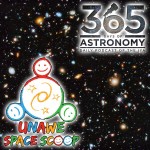Podcaster: Richard Drumm
 Title: Space Scoop: A Journey to the Edge of the Universe
Title: Space Scoop: A Journey to the Edge of the Universe
Organization: Astrosphere New Media
Link : astrosphere.org ; http://unawe.org/kids/unawe1421/
Description: Space scoop, news for children.
Bio: Richard Drumm is President of the Charlottesville Astronomical Society and President of 3D – Drumm Digital Design, a video production company with clients such as Kodak, Xerox and GlaxoSmithKline Pharmaceuticals. He was an observer with the UVa Parallax Program at McCormick Observatory in 1981 & 1982. He has found that his greatest passion in life is public outreach astronomy and he pursues it at every opportunity.
Today’s sponsor: This episode of “365 Days of Astronomy” is sponsored by — no one. We still need sponsors for many days in 2013, so please consider sponsoring a day or two. Just click on the “Donate” button on the lower left side of this webpage, or contact us at signup@365daysofastronomy.org.
Transcript:
This is 365 Days of Astronomy. Today we bring you a new episode in our Space Scoop series. This show is produced in collaboration with Universe Awareness, a program that strives to inspire every child with our wonderful cosmos.
A Journey to the Edge of the Universe
What happens when you point the Hubble Space Telescope at a seemingly empty patch of sky? Well you get a view that takes you to the very edge of the Universe!
The photograph used in this episode’s album artwork shows a tiny patch of sky. If you lined-up 10 similar sized patches of sky in a row, the whole thing still wouldn’t appear as wide as the Moon. But, despite being so small, this one patch of sky contains around 10,000 galaxies, some of which are over 13 billion light years away from Earth!
This tiny patch of sky was previously photographed by Hubble in 2004, but the original image left astronomers in a curious position. The picture told them a lot about stars being born in nearby galaxies and also star birth in the most distant galaxies.
However, there was very little data on star-formation happening in between, at a distance of 5 to 10 billion light years away (which is 5 to 10 billion years ago). This happens to be the period of time in which most of the stars in the Universe were formed, so there has to be star formation going on. A lot of it!
This left a significant gap in our knowledge of the hottest, most massive and youngest stars.
These stars radiate away large amounts of ultraviolet light (that’s the kind of high energy light that causes sunburn). So, NASA and the European Space Agency (ESA) used the Hubble Space Telescope to carry out a study called the Ultraviolet Coverage of the Hubble Ultra Deep Field (UV-UDF) project, to fill in this gap in our knowledge. This picture is composed of a mosaic of many images collected during this project.
By observing using ultraviolet light, this project may help us to fully understand how stars formed and how galaxies grew in size from small collections of very hot stars to the massive structures they are today.
Here’s a Cool Fact
The Hubble Ultra Deep Field image was just one of a number of images taken by NASA and ESA. The latest is called the eXtreme Deep Field and was created by combining Hubble images taken over 10 years. The faintest galaxies in that photograph are 10 billion times fainter than the human eye can see!
Thank you for listening to the 365 Days of Astronomy podcast!
365 Days of Astronomy is a community podcast made possible thanks to the contributions of people like you. Please consider donating at 365DaysofAstronomy.org/Donate
End of podcast:
365 Days of Astronomy
=====================
The 365 Days of Astronomy Podcast is produced by Astrosphere New Media. Audio post-production by Richard Drumm. Bandwidth donated by libsyn.com and wizzard media. You may reproduce and distribute this audio for non-commercial purposes. Please consider supporting the podcast with a few dollars (or Euros!). Visit us on the web at 365DaysOfAstronomy.org or email us at info@365DaysOfAstronomy.org. In the new year the 365 Days of Astronomy project will be something different than before….Until then…goodbye

